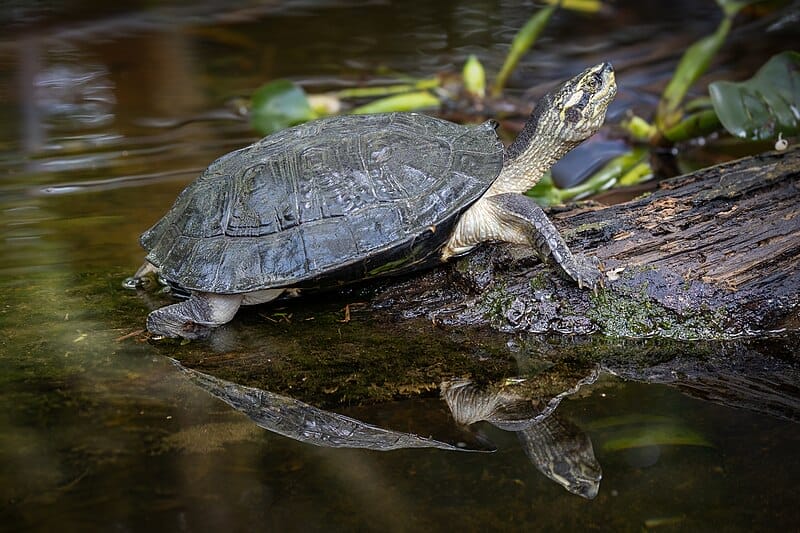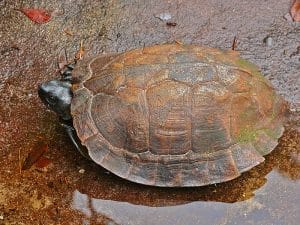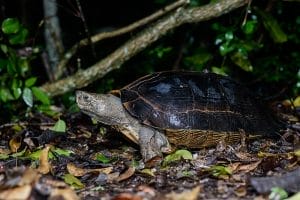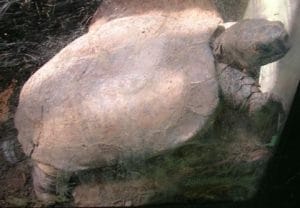Heosemys annandalii (yellow-headed temple turtle)
Home > Turtle Database > Heosemys annandalii (yellow-headed temple turtle)
Heosemys annandalii, commonly known as the Yellow-headed Temple Turtle, is a large freshwater turtle native to Southeast Asia. Recognized for its distinctive yellow markings on the head, this species often inhabits temple ponds, which contributes to its common name.
Native To These Regions
Cambodia, Laos, Malaysia, Thailand, VietnamNative Turtle Species Map – Find Turtles by Region
Scientific Classification
- Kingdom: Animalia
- Phylum: Chordata
- Class: Reptilia
- Order: Testudines
- Family: Geoemydidae
- Genus: Heosemys
- Species: Heosemys annandalii
Common Names
- Yellow-headed Temple Turtle
- Annandale’s Terrapin
This Hilarious Turtle Book Might Know Your Pet Better Than You Do
Let’s be real—most turtle care guides feel like reading a textbook written by a sleep-deprived zookeeper.
This one’s not that.
Told from the snarky point of view of a grumpy, judgmental turtle, 21 Turtle Truths You’ll Never Read in a Care Guide is packed with sarcasm, sass, and surprisingly useful insights.
And hey—you don’t have to commit to the whole thing just yet.
Grab 2 free truths from the ebook and get a taste of what your turtle really thinks about your setup, your food choices, and that weird plastic palm tree.
It’s funny, it’s honest, and if you’ve ever owned a turtle who glares at you like you’re the problem—you’ll feel seen.
Identification
Description
Heosemys annandalii is one of the larger turtle species, with adults reaching up to 50 cm (20 inches) in carapace length. The carapace is dark brown to black, while the plastron is lighter in color. Its most distinguishing feature is the bright yellow or cream-colored markings on the sides of its head and neck.
Sexual Dimorphism
Males typically have longer and thicker tails than females, with the vent (cloacal opening) positioned further from the base of the tail. Females generally have a broader carapace and may grow slightly larger than males.
Check more turtles from the Heosemys genus
Native Origin and Distribution
Geographical Range
This species is native to Southeast Asia, specifically in countries like Thailand, Laos, Cambodia, Vietnam, and Malaysia. It inhabits freshwater ecosystems within these regions.
Preferred Habitat
Heosemys annandalii prefers slow-moving freshwater habitats such as rivers, swamps, marshes, and ponds. It thrives in areas with abundant aquatic vegetation, which provides both food and shelter.
Behavior
Feeding Habits
An omnivorous species, the Yellow-headed Temple Turtle feeds on a diverse diet that includes aquatic plants, fruits, invertebrates, and small fish. Its feeding habits contribute to the ecological balance of its habitat.
Predators
Natural predators include large fish, birds of prey, and mammals. Eggs and juveniles are particularly vulnerable to predation due to their smaller size and softer shells.
Reproduction
Breeding Season
Breeding typically occurs during the wet season, although the exact timing can vary depending on the regional climate.
Reproductive Method
Females lay clutches of 2–6 eggs in nests dug into sandy or muddy banks. The incubation period ranges from 70 to 90 days, influenced by environmental conditions like temperature and humidity.
Conservation
Extinction Status
Heosemys annandalii is classified as Critically Endangered on the IUCN Red List.
Threats
- Habitat Loss: Wetland drainage and deforestation have significantly reduced their natural habitats.
- Over-collection: The species is hunted for its meat, used in traditional medicine, and captured for the pet trade.
- Pollution: Water pollution affects both their health and food sources.
Conservation Measures
- Legal Protection: Listed under CITES Appendix II, regulating international trade.
- Habitat Conservation: Efforts to preserve and restore natural habitats are ongoing.
- Breeding Programs: Captive breeding initiatives aim to bolster wild populations.
Economic Importance
The Yellow-headed Temple Turtle holds cultural significance in some regions, often kept in temple ponds where they are fed by monks and visitors. Economically, they are part of the pet trade and are sometimes used in traditional medicine and cuisine, contributing to local economies.
Interesting Facts
- The species gets its name from being commonly found in temple ponds, symbolizing longevity and good fortune.
- Heosemys annandalii can live for several decades, especially when provided with proper care in captivity.
- Their presence in aquatic ecosystems helps control vegetation growth and maintain ecological balance.

About Author
Muntaseer Rahman started keeping pet turtles back in 2013. He also owns the largest Turtle & Tortoise Facebook community in Bangladesh. These days he is mostly active on Facebook.















